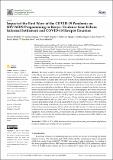| dc.contributor.author | Muhula, Samuel | |
| dc.contributor.author | Opanga, Yvonne | |
| dc.contributor.author | Oramisi, Violet | |
| dc.contributor.author | Ngugi, Catherine | |
| dc.contributor.author | Ngunu, Caroline | |
| dc.contributor.author | Carter, Jane | |
| dc.contributor.author | Marita, Enock | |
| dc.contributor.author | Osur, Joachim | |
| dc.contributor.author | Memiah, Peter | |
| dc.date.accessioned | 2022-01-26T14:48:11Z | |
| dc.date.available | 2022-01-26T14:48:11Z | |
| dc.date.issued | 2021-06-03 | |
| dc.identifier.citation | Muhula S, Opanga Y, Oramisi V, Ngugi C, Ngunu C, Carter J, Marita E, Osur J, Memiah P. Impact of the First Wave of the COVID-19 Pandemic on HIV/AIDS Programming in Kenya: Evidence from Kibera Informal Settlement and COVID-19 Hotspot Counties. Int J Environ Res Public Health. 2021 Jun 3;18(11):6009. doi: 10.3390/ijerph18116009. PMID: 34205036; PMCID: PMC8199875. | en_US |
| dc.identifier.other | PMID: 34205036 | |
| dc.identifier.other | PMCID: PMC8199875 | |
| dc.identifier.other | DOI: 10.3390/ijerph18116009 | |
| dc.identifier.uri | https://repository.amref.ac.ke/handle/123456789/533 | |
| dc.description | Copyright: © 2021 by the authors.
Licensee MDPI, Basel, Switzerland.
This article is an open access article
distributed under the terms and
conditions of the Creative Commons
Attribution (CC BY) license (https://
creativecommons.org/licenses/by/
4.0/). | en_US |
| dc.description.abstract | The study sought to determine the impact of COVID-19 on HIV/AIDS programming
in the Kibera informal settlement and COVID-19 hotspot counties during the first wave of the
pandemic. The study was conducted in two phases. The first phase entailed the analysis of HIV
care and treatment secondary data (2018–2020) from the Kenya Health Information System. In the
second phase, a prospective cohort study was conducted among people living with HIV in the
Kibera informal settlement. A total of 176 participants aged 18 years and above accessing HIV
services at selected healthcare facilities in Kibera were randomly sampled from facility electronic
medical records and followed up for three months. Socio-demographics and contact details were
abstracted from the records and telephone interviews were conducted with consenting participants.
Results from the retrospective review of HIV program data indicated a 56% (p < 0.000, 95% CI:
31.3%–62.8%) reduction in uptake of HIV services. Clients starting antiretroviral therapy (ART)
reduced significantly by 48% (p < 0.001, 95% CI: 35.4%–77%) in hotspot counties. However, preexposure
prophylaxis uptake increased significantly by 24% (p < 0.019, 95% CI: 4%–49%). In Kibera,
14% reported missing medications at the onset of the COVID-19 pandemic because of lack of food
(38%) and government measures (11%), which affected ART access; 11% did not access health
facilities due to fear of contracting COVID-19, government regulations and lack of personal protective
equipment. Socioeconomic factors, food insecurity and government measures affected uptake of
HIV/AIDS services; hence, the need for scaling up measures to increase access to HIV/AIDS services
during the onset of pandemics. | en_US |
| dc.description.sponsorship | Amref Health Africa Headquarters | en_US |
| dc.language.iso | en | en_US |
| dc.publisher | MDPI | en_US |
| dc.subject | COVID-19 | en_US |
| dc.subject | HIV/AIDS | en_US |
| dc.subject | Antiretroviral therapy | en_US |
| dc.subject | Food security | en_US |
| dc.subject | Pre-exposure prophylaxis | en_US |
| dc.subject | Lockdown measures | en_US |
| dc.subject | Personal protective equipment | en_US |
| dc.title | Impact of the First Wave of the COVID-19 Pandemic on HIV/AIDS Programming in Kenya: Evidence from Kibera Informal Settlement and COVID-19 Hotspot Counties | en_US |
| dc.type | Article, Journal | en_US |

